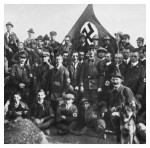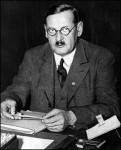
The National Socialist German Workers’ Party (better known as the NSDAP or Nazi Party) sprang from humble beginnings. In January 1919 a nationalist political group calling itself the Deutsche Arbeitpartei (DAP, or German Workers’ Party) was formed in Bavaria. This itself was not particularly remarkable. Post-war Germany was a hotbed of political ideas and had given rise to scores of fledgeling political groups like the DAP. There nothing particularly remarkable about the DAP’s founding members. Anton Drexler was a factory worker and aspiring poet who had supported German involvement in World War I, though he had not enlisted himself. Gottfried Feder was an economist with a grudge against greedy bankers. Karl Harrer and Dietrich Eckart were insignificant figures, both previously involved in publishing nationalist and anti-Semitic pamphlets. All four men had connections with Germany’s volkisch movement, a group that was obsessed with romantic notions about race, patriotism and homeland. All were strong nationalists who were convinced that Germany’s surrender in November 1918 was an act of treachery, engineered by Jews and socialists to destroy the country and enslave its people. Together Drexler and his associates coddled together a few dozen followers and formed the DAP. This group met sporadically through 1919. At these meetings they cursed the failures of the new democratic government and the forces they believed threatened Germany.
The fate of the DAP changed forever with the arrival of a new member. Immediately after the war the Reichswehr (German military) was tasked with monitoring and infiltrating newly formed political groups, particularly if they might harbour communist revolutionaries. In the autumn of 1919 an Austrian-born corporal, a decorated veteran of the Western Front, was ordered to join the DAP and report back on its activities. The agent’s name was Adolf Hitler. Hitler began attending DAP meetings in September 1919 – but instead of dutifully reporting what was being discussed, the 30-year-old corporal became swept up in the DAP’s passionate debates about the fate of Germany, her people and politics. At Hitler’s second meeting, when someone suggested that Bavaria break away from Germany and unify with Austria, Hitler leapt to his feet and delivered an impromptu speech against the idea. Those present were struck by the newcomer’s forceful oratory. By the end of September Hitler chose to join the DAP and cease spying on it. He resigned from the army and became the group’s 55th member. Over the following year, Hitler refined his talent for political speeches, becoming one of the best orators in the small party.

In early 1920 the DAP began to grow and reform, in part due to Hitler’s influence. It reinvented itself as the Nationalsozialistische Deutsche Arbeiterpartei (NSDAP, or National Socialist German Workers’ Party). The term ‘Nazi’, an abbreviation of National Socialist devised by a journalist, was not widely used until around 1930 and remained unpopular within the party itself. During this period Hitler worked for the party as an organiser, propagandist and public speaker. In February 1920 he convened a party rally attended by 2,000 people, the NSDAP’s largest gathering to that point. He also assisted Drexler and Feder with drafting the NSDAP’s political manifesto, a 25 point list of its core ideas and policies. By mid-1921 most NSDAP members, including Drexler himself, acknowledged Hitler to be the party’s obvious leader. In July 1921 Drexler stood down as chairman, allowing Hitler to fill this role. Two months later Hitler scrapped the NSDAP’s council and declared himself the party’s Fuhrer (absolute leader). Two years after joining the DAP Hitler was now solely responsible for policy and decision making. He ordered the formation of a paramilitary branch, the Sturmabteilung (the SA, later known as the ‘Brownshirts’) to deal with political opponents. He also formed the Hitler-Jugend (Hitler Youth) to attract young people to the party, acquired a newspaper and adopted the swastika (a common good luck motif) as the party’s emblem. By the end of 1921, the NSDAP had several thousand members, a significant improvement on the few dozen it contained in late 1919.
“Since the inception of the Nazi Party, social scientists have attempted to define its nature in terms of its membership. Scholars have described the party variously as a class movement, a regional movement, an anti-urban revolt against modernity, a generational revolt, and even as a collection of losers, cut-throats and criminals.”
Paul Madden, historian
The NSDAP grew slowly through 1921-22. It was popular with ex-soldiers, who identified with the decorated war veteran Hitler, sympathising with his passionate nationalism and his attacks on the Weimar government. Small businessmen and unemployed workers, in search of answers to their own miseries, also joined the group. Hitler’s rousing speeches identified and honed in on convenient scapegoats: the ‘November criminals’ who signed the armistice, liberals and socialists who signed the hated Treaty of Versailles, communists who threatened revolution, the Jewish bankers and conspirators who plotted to undermine and destroy the German state. Well oiled by free beer supplied at NSDAP meetings and rallies, Hitler’s audiences lapped up these conspiracy theories, hanging on the fuhrer’s every word and applauding his calls for the overthrow of the Weimar government. Yet for all their popularity in and around Munich, Hitler and the NSDAP were, in the early 1920s, still a regional phenomenon. Their supporter base was mostly in Bavaria while they were hardly known in northern, western or central Germany or the capital Berlin. This was a problem Hitler and his followers had to address if they were to one day rule the entire nation.
1. The Nazi Party or National German Workers’ Party (NSDAP) began life as the German Workers’ Party (DAP). It was formed by a small group of nationalists in January 1919.
2. Adolf Hitler first attended DAP meetings in September 1919, after being sent to spy on it for the Reichswehr. Hitler soon joined the DAP and rose to prominence within the group.
3. In 1920 the DAP re-formed as the NSDAP. Hitler was one of the key figures in its reorganisation, expansion and ideological platform, and by September 1921 he had become its Fuhrer (leader).
4. The NSDAP was primarily a nationalist party that sought the restoration of German power, prosperity and prestige. It was popular with ex-soldiers, failed businessmen and unemployed blue collar workers.
5. The NSDAP continued to grow through 1921-22, reaching a membership of several thousand people – however its supporter base remained very much in southern Germany, mainly in Bavaria.
© Alpha History 2018. Content on this page may not be republished or distributed without permission. For more information please refer to our Terms of Use.
This page was written by Jennifer Llewellyn, Jim Southey and Steve Thompson. To reference this page, use the following citation:
J. Llewellyn et al, “The Nazi Party”, Alpha History, accessed [today’s date], https://alphahistory.com/nazigermany/the-nazi-party/.

